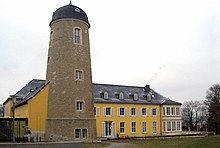Villa Sauckel
The so-called Villa Sauckel is a building in Weimarer Windmühlenstraße 19/21, which was originally built as a service villa of the Thuringian NSDAP Gauleiter Fritz Sauckel . Today it is the training center of the Federal Employment Agency .
history
In 1938/1939 the architect Hermann Giesler built the spacious service villa of the NSDAP Gauleiter Thuringia as a three-wing complex in the style of a city palace, based on an old Turmholländer windmill , which was included in the design. The workers required to build the villa were recruited from the nearby Buchenwald concentration camp .
Gauleiter Fritz Sauckel was evidently very satisfied with the result, because on November 4, 1938 he made Giesler an honorary citizen of the city of Weimar. The possibility of such a building can also be attributed to the fact that Sauckel was in special favor of Adolf Hitler and that Hitler considered him very reliable. Weimar was also interested in Weimar in terms of cultural policy. Also in 1938, the Hotel Elephant was reopened according to Giesler's plans .
The host, Fritz Sauckel, lived in the villa from 1938 to 1945 with his wife and ten children, with two concentration camp inmates doing housework. The writer and painter Armin Müller , who wrote the text for the cantata Die Glocke von Buchenwald , lived in the immediate vicinity of the villa .
In the years 1996 to 2000 the building was renovated, whereby it remained structurally unchanged for reasons of monument protection. However, there were extensions and the outdoor area was redesigned. Since then, the house has been an educational facility of the Federal Employment Agency / Regional Directorate Saxony-Anhalt Thuringia and one of the two nationwide competence centers SGB II. The villa is also used for cultural events.
construction
The street side presents itself as a complex with a middle section and two side wings in neoclassical style, with a larger green area in front of it. The mill tower protrudes from the garden, i.e. the south side. There are also fruit tree plantations there. The mill was painted in 1890 by Theodor Hagen , a representative of the Weimar School of Painting . This oil painting on canvas in the Weimar art collections bears the inventory number G 660. This mill was built in 1843 and was in operation until 1880.
documentary
This villa is also the original location for scenes in a film about Gauleiter Sauckel broadcast on August 16, 2009 under the title: Fritz Sauckel - Hitler's husband in Thuringia based on the book by Winifred König and directed by Dirk Otto .
literature
- Annette Seemann , Constantin Beyer: Weimar. The most important buildings. Edition Leipzig, Leipzig 2005, ISBN 3-361-00596-5 , p. 133 (Villa Fritz Sauckels).
- Administrative school of the Federal Employment Agency. In: Joachim Schulz: Architectural Concrete Atlas: Planning - Execution - Examples. Vieweg + Teubner, Wiesbaden 2009, ISBN 978-3-8348-0261-3 , pp. 191-196. ( Online )
Web links
Individual evidence
- ↑ Karina Loos: The staging of the city. Planning and building under National Socialism in Weimar. Dissertation. Bauhaus University Weimar, 1999, p. 373.
- ↑ Hans Wilm Schütte: Weimar painter Bädeker & f = false Baedeker travel guide Weimar. P. 228.
- ↑ http://archiv.ub.uni-heidelberg.de/artdok/4529/1/Ziegler_Klein_Paris_1999.pdf Original publication in: Rolf Bothe, Thomas Föhl (Ed.): Rise and Fall of Modernity. [An exhibition by the Weimar Art Collections and Weimar 1999 - European City of Culture GmbH in Zsarb. with the German Historical Museum Berlin]. Ostfildern-Ruit 1999, pp. 14-39.
- ^ Gitta Günther , Wolfram Huschke , Walter Steiner (eds.): Weimar. Lexicon on city history. Hermann Böhlaus successor, Weimar 1998, ISBN 978-3-7400-0807-9 , p. 497.
- ↑ Axel Stefek (Ed.): Energy in Weimar: From the Middle Ages to the Modern Age (= energy history of the city of Weimar. Vol. 1). Edited by the Stadtwerke Weimar Stadtversorgungs-GmbH by Axel Stefek. Weimar 2016, pp. 151–161 Chapter 4.2 .: The Dutch mill in the south of the city of Weimar. Here is a detailed description of the history of the construction and use of this windmill.
- ^ Fritz Sauckel - Hitler's husband in Thuringia in the MDR series History of Central Germany , accessed on March 20, 2011 ( Memento from February 17, 2013 in the Internet Archive )
Coordinates: 50 ° 58 ′ 19.2 " N , 11 ° 18 ′ 53.9" E

